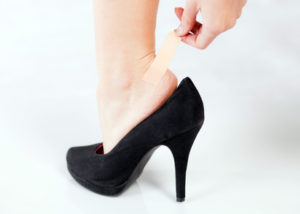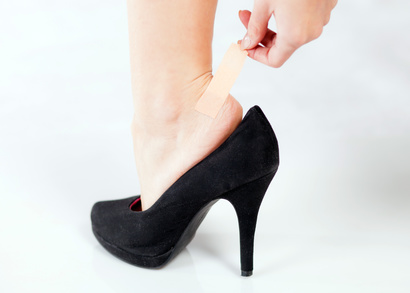Wearing Shoes After Blisters aint Easy!
If you have ever worn footwear of any kind you have probably experienced the PAIN of a blister. Wearing shoes after Blisters can be a nightmare bordering on impossible. Preventing or managing blisters once they have occurred, and getting back Into shoes, is a matter of art, science and effort. Discover the what, how, why and where of wearing shoes (not just slippers) after blisters
What is a Blister?
When we forcefully rub, freeze, scald, or apply harmful chemicals to our skin, it throws up the defence we call a blister. The liquid under it acts as a cushion to prevent the damage spreading to deeper layers of our skin, and help it heal. The nature of this liquid varies. It is often white blood cells. Sometimes it is blood, or pus where there is an infection. Let us dig a little deeper into how we end up with painful blisters.
5 Ways to Get Blisters on your Feet

Blister caused by shoe rubbing on heal
Did you know our skin is our largest organ and our primary defence? Its seven layers guard our muscles, ligaments, bones, and organs from infection. It is our protection against diseases and dehydration. It does a good job, but it cannot take unlimited abuse like this:
- Rubbing, also known as friction, over a period of time may result in the layers of our skin trying to defend itself with a blister. This can happen to our feet if we walk a distance with our feet slipping or moving against our footwear or even moving against our socks or stockings. It is the repetition of the slipping, rubbing or friction that causes the blister. It may be a badly fitting shoe that could be too loose, or too tight or flip-flops rubbing in between the toes, or strappy sandals. Even a crease or fold in a sock can be the culprit. Blistering occurs more often on moist, sweaty skin, as opposed to dry. However even dry feet can fall victim to blisters. Less aggressive, but repetitive rubbing may lead to calluses rather than blisters. Either way, the resultant pain is not much fun!
- Rubbing plus Pinching or extreme Pressure can result in Blood Blisters. The presence of a break in a quite small blood vessel will cause the blood to leak into the space between two or more layers of skin. The black, or very very dark red color can be alarming and a strong reminder to address the cause.
- Temperature Extremes also cause blisters on the feet. Chilblains, or even Frostbite can cause the skin to blister. Sunburn or immersing your feet in very hot water can result in blisters. Blisters caused by exposure to very high or very low temperatures for short or long periods can be a very serious medical event. Long term damage and/or infection of the skin is a real risk, so stay alert2
- Chemicals can cause blistering too. Common ones in nature are poison ivy and poison oak, so be careful where you walk and climb especially in bare feet. We can also experience contact dermatitis from some cosmetics and detergents. Individual sensitivity varies. Let us not forget accidental spills of dry ice and gasoline. These are more common than you might think – especial men, out in the workshop in summer..
- Medical Conditions sometimes present as blistering. Eczema, psoriasis and some other less common dermatological conditions may cause the skin on the feet to blister. Speak to your doctor the moment you feel concern.
Healing Blisters, and Getting Back Into Shoes
Most blistering on feet is the result or friction, or something rubbing persistently against the skin, usually footwear. As the upper layers of skin start to separate, fluid flows in to begin the healing. First, it helps new cells divide and become new connective tissue. Then it reabsorbs itself into our body. Well that is what happens if you stop the friction. If the friction continues, unabated, more tissue damage starts. The skin breaks, more layers of skin separates, more layers of skin become damaged and a wound develops…and, oh yes, PAIN, serious pain. Wearing shoes after blisters is usually the last thing on your mind but sometimes you just have to…so what do you do next?
Wearing Shoes after Blisters – before it’s too late
Be Prepared…Wear new shoes, sandals, flip flops for only 10 minutes per day for 7 days until the footwear eases to your foot anatomy and the activities that you do. Be aware of anything that doesn’t feel quite right. The back of the heel, a little toe, the ball of the foot.
Be Pro-Active…Protect your sensitive spots with tape before you start your activity. Maybe a heel lift (talk to your Podiatrist) will work for your recurrent heel blister. Perhaps an anti-perspirant to reduce foot sweating. What about some leather softener on your strappy shoes that you haven’t worn for a while?
Before its Too Late… You feel a twinge, a little bit of pain, friction and damage has started…. STOP. Try to identify the cause. TAKE ACTION. Tape the spot, phone a taxi, remove wet socks and put on dry ones, change footwear, ask someone to carry you?
Wearing Shoes after Blisters – after it’s too late
A Podiatrist’s Tips for Healing a Blister Successfully
Number One Take off your shoes, sandals or flip flops – whatever has been rubbing – they are no longer your friend or your favourite. Your job now is to completely heal the damaged skin. Not half healed but completely durable and fabulous again.
If the skin is intact, let nature do its work. Do not prick the blister as you could invite infection. Leave it open to the air if you can. If need be, cover it over lightly with a loose plaster or gauze dressing as a cushion. Allow the skin to come away naturally, as the healing completes. Try not to pick at it
If the blister bursts, allow it to drain naturally and wash clean with mild soap and water. Leave the skin alone as it is protecting the new skin inside. Cover over with a dry sterile dressing to protect it. At the first sign of any pus, speak to a medical provider as soon as possible. If part of the old skin rubbed off, do not pick away at the rest.
For recurrent blisters – the ones that athletes and dancers find more difficult to manage – please consult an experienced sports podiatrist or sportsphysician who has a few extra tricks in their blister-kit-bag.
On a more serious note: If you are a diabetic or have underlying circulation problems seek assistance. Sometimes a blister is more serious than it looks. Early intervention can be critical
Generally however, about the only good thing about blisters is they do eventually heal: Then we can start Wearing Shoes after Blisters , having learned our foot care lessons, without a new episode of blistering pain!


Recent Comments